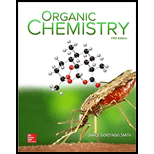
(a)
Interpretation: The product formed for the given Diels-Alder reaction in which compound containing triple bond is Diels-Alder dienophiles is to be drawn.
Concept introduction: Diels-alder reaction is a cycloaddition reaction in which two molecules combine to form a new ring. In this type of reaction, syn addition takes place. It is a reaction between diene with a dienophile to yield a cyclohexene. The dienophile adds to one side of the diene, and diene adds to the one side of the dienophile. Thus, they have syn stereochemistry.
(b)
Interpretation: The product formed for the given Diels-Alder reaction in which compound containing triple bond is Diels-Alder dienophiles is to be drawn.
Concept introduction: Diels-alder reaction is a cycloaddition reaction in which two molecules combine to form a new ring. In this type of reaction, syn addition takes place. It is a reaction between diene with a dienophile to yield a cyclohexene. The dienophile adds to one side of the diene, and diene adds to the one side of the dienophile. Thus, they have syn stereochemistry.
Want to see the full answer?
Check out a sample textbook solution
Chapter 16 Solutions
PKG ORGANIC CHEMISTRY
- What diene and dienophile are needed to prepare attached compound by aDiels–Alder reaction?arrow_forwardDraw the product (A) of the following Diels–Alder reaction. A was a key intermediate in the synthesis of the addicting pain reliever morphine, the chapter-opening molecule.arrow_forwarda.How many π electrons does C contain? b.How many π electrons are delocalized in the ring? c.Explain why C is aromatic.arrow_forward
- Deconstruct the given Diels–Alder adduct. Draw the reactants (A and B), in any order, that would be needed to produce the Diels–Alder adduct.arrow_forwardWhich diene in each pair has the larger heat of hydrogenation?arrow_forwardDevise a stepwise synthesis of each compound from dicyclopentadiene using a Diels–Alder reaction as one step. You may also use organic compounds having ≤ 4 C's, and any required organic or inorganic reagents.arrow_forward
- Devise a stepwise synthesis of attached compound from dicyclopentadiene using a Diels–Alder reaction as one step. You may also use organic compounds having ≤ 4 C's, and any required organic or inorganicreagents.arrow_forwardWhich is an energy diagram for a concerted reaction (SN2 and E2)? A B C Darrow_forwardProvide the neccessary reagents next to the arrowsarrow_forward
 Organic Chemistry: A Guided InquiryChemistryISBN:9780618974122Author:Andrei StraumanisPublisher:Cengage Learning
Organic Chemistry: A Guided InquiryChemistryISBN:9780618974122Author:Andrei StraumanisPublisher:Cengage Learning
